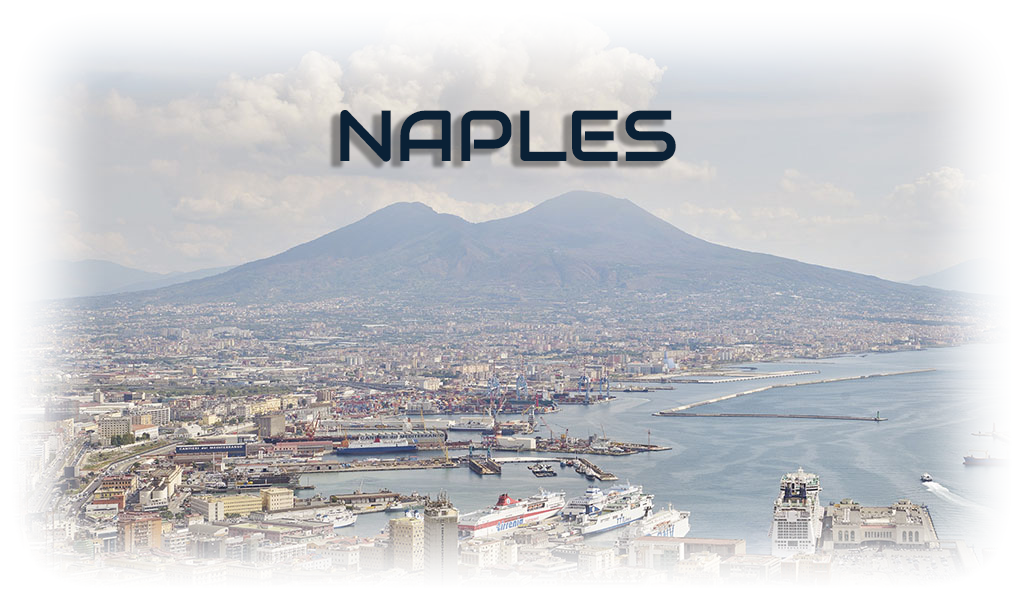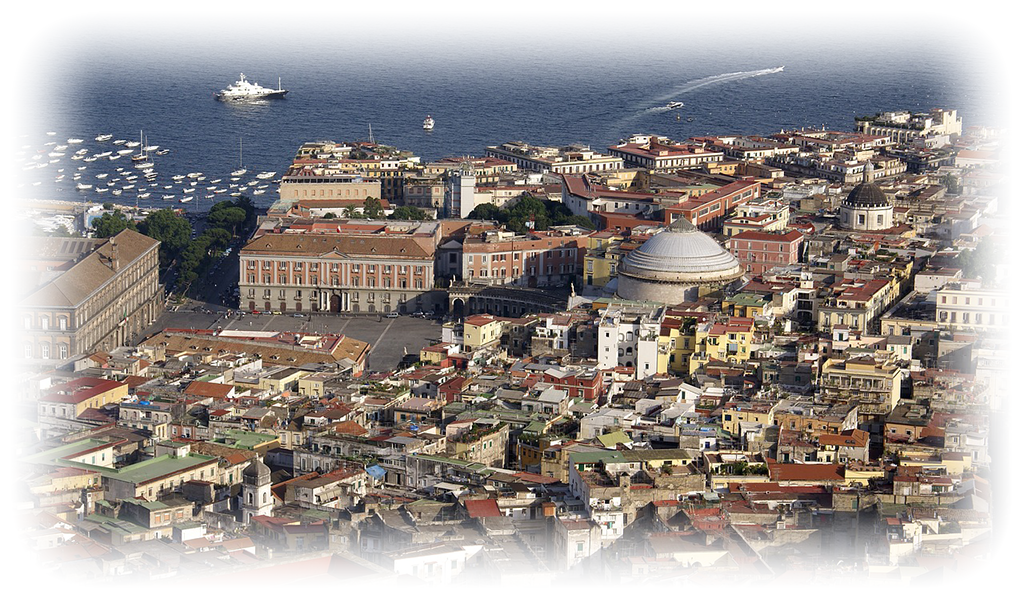
Naples is the capital of southern Italy and the Campania region. The city is located at the foot of Mount Vesuvius in the Gulf of Naples and is the third most populous in the country, second only to Rome and Milan. Naples is a city with a real Italian temperament, lush, chaotic, colorful. Narrow, slightly dirty streets and old shabby buildings give it an atmosphere of despair. It seems that this city never sleeps. It is always noisy, fun, music can be heard in the streets and the aromas of pizza (which was probably invented here and the Neapolitans themselves consider it the best in the world) and coffee.
Naples is a very ancient city which was founded by the ancient Greeks. And its name can be translated as "new city". Despite all its problems it is extremely interesting, but Naples is still often deprived of the attention of tourists. Although the historic city center has earned the honor of being included in the UNESCO World Heritage List. Not only is it the largest of the world's historic centers, but it also boasts 448 historic and monumental churches.
Geography and weather
Naples is located on the coast of the Gulf of the same name which is part of the Tyrrhenian Sea. The Tyrrhenian Sea, in turn, is part of the Mediterranean Sea. The city lies in a dangerous neighborhood with Mount Vesuvius. The terrain rises from sea level to 450 meters. The climate is Mediterranean humid subtropical. Summers are hot, winters are warm. About 1000 mm of precipitation falls per year.
History and interesting facts
Naples was founded by the ancient Greeks around the 8th century BC. Therefore it can be considered one of the oldest cities in Europe. Originally the population was called Parthenope, but in the 6th century it was renamed Naples. The new city was important in Greek civilization and was an important center of trade. Eventually Naples became a Roman colony and the gateway through which ancient Greek culture entered Roman.
After the fall of the Roman Empire the city was conquered first by the Ostrogoths then by the Byzantines. In 763 it was for some time under the control of the Pope. In the 8-11th century, Naples was the capital of the duchy of the same name. In 1139 the city became part of the Kingdom of Sicily and in 1266 became its capital. At the end of the 13th century the kingdom disintegrated. In the 16th century it was under Italian control for some time. Until the 17th century Naples was one of the largest cities in Europe, second only to Paris.
Naples joined Italy in 1861. Much of modern Naples was built during the Mussolini regime, as well as during the post-World War II reconstruction.
Naples is a very ancient city which was founded by the ancient Greeks. And its name can be translated as "new city". Despite all its problems it is extremely interesting, but Naples is still often deprived of the attention of tourists. Although the historic city center has earned the honor of being included in the UNESCO World Heritage List. Not only is it the largest of the world's historic centers, but it also boasts 448 historic and monumental churches.
Geography and weather
Naples is located on the coast of the Gulf of the same name which is part of the Tyrrhenian Sea. The Tyrrhenian Sea, in turn, is part of the Mediterranean Sea. The city lies in a dangerous neighborhood with Mount Vesuvius. The terrain rises from sea level to 450 meters. The climate is Mediterranean humid subtropical. Summers are hot, winters are warm. About 1000 mm of precipitation falls per year.
History and interesting facts
Naples was founded by the ancient Greeks around the 8th century BC. Therefore it can be considered one of the oldest cities in Europe. Originally the population was called Parthenope, but in the 6th century it was renamed Naples. The new city was important in Greek civilization and was an important center of trade. Eventually Naples became a Roman colony and the gateway through which ancient Greek culture entered Roman.
After the fall of the Roman Empire the city was conquered first by the Ostrogoths then by the Byzantines. In 763 it was for some time under the control of the Pope. In the 8-11th century, Naples was the capital of the duchy of the same name. In 1139 the city became part of the Kingdom of Sicily and in 1266 became its capital. At the end of the 13th century the kingdom disintegrated. In the 16th century it was under Italian control for some time. Until the 17th century Naples was one of the largest cities in Europe, second only to Paris.
Naples joined Italy in 1861. Much of modern Naples was built during the Mussolini regime, as well as during the post-World War II reconstruction.

How to get there
Naples has Capodicino International Airport. From the airport to the city can only be reached by bus which has only two stops: Stazione Centrale (Central Station) and Piazza Municipio. The railway connection is developed almost immediately by all major cities of Italy. Naples is connected to Rome by the A1 motorway. Motorways in Italy are tolled. The city is a large port. Ferries and large passenger ships connect Naples with Sicily, Sardinia, Tunisia and Corsica. You can use the metro, trams and buses to get around the city.
Food and drink
Naples is the gastronomic capital of southern Italy. It is believed that the first pizza was made right here. Neapolitan pizza has a thicker dough. If you want to try "real Neapolitan pizza", go to Pizzeria Brandi, where Margarita pizza was "born". Excellent pizza is also made in the Via dei Tribunali area. Finding a good pizzeria is easy enough. Step away from popular hiking trails. See if there are many locals in this establishment. If so, you can safely order there. Neapolitan cuisine also includes many seafood dishes, pasta with various sauces. Coffee, wine and the famous limoncella are popular drinks.
Attractions
Throughout history Naples has witnessed fierce battles and many civilizations have sought to conquer it. Greeks, Romans, Spaniards, French, each of these peoples left its mark. Here, on the narrow streets among the old buildings, ancient monuments, ancient churches, the real story is frozen.
Pompeii is the legendary ancient city destroyed during the devastating eruption of Vesuvius in 79 AD at the peak of its power. Despite the streams of lava and tons of ash that buried the city and its inhabitants, it remained in fantastic condition. Pompeii are great ruins. Roads, walls of houses, fragments of temples, public buildings and even frescoes in some houses have been preserved here. The most interesting places - the ruins of the amphitheater, Roman theaters, baths, the surroundings of the Forum, the temples of Apollo and Jupiter. Pompeii was quite a large and developed city at that time. Even now the excavations here are not completely completed. And among various archeological finds there are fossilized remains of unfortunate people, the last inhabitants of Pompeii.
Herculaneum is another city destroyed by Vesuvius. Although he was farther from the waking volcano than Pompeii, it did not save him. Herculaneum is actually much better preserved. Some buildings still have some wooden structures, frames and a roof. Interesting sights of these ruins - Villa Papiri and the house of Argus which survived beautiful frescoes and murals.
Castel Nuovo is one of the symbols of Naples, a huge and powerful medieval castle located on the shores of the Gulf of Naples, in close proximity to the famous Piazza del Plebiscito. The castle is a fortress with 5 powerful towers. The triumphal arch of the early Renaissance is the entrance. Castel Nuovo was built in the 13th century and was the residence of the kings and governors of Naples. Now there is a city museum with various collections and paintings with an emphasis on Italian painting of the 19th century.
Castel del Ovo is a stunning medieval castle on the island. It is the oldest surviving fortification of Naples. The date of foundation of the fortress dates back to the 6th century. Castel del Ovo is currently open to the public.
Piazza del Plebescito is the most famous square in Naples. This large open space is filled with important buildings and statues: the royal court and the Royal Basilica with a colonnade (or rather San Francesco di Paola, built in the 19th century on the model of the Pantheon), Palazzo Salerno, the Prefecture Palace and a statue of Charles III, King of Spain .
The Duomo is the cathedral and the most important church in Naples. Built in the 13th century by Charles I of Anjou on the foundations of ancient churches. This religious building combines many styles, including Gothic, Renaissance and Baroque. The cathedral has a large central tower and many decorative sculptures and other ornaments.
San Domenico Maggiore is an unusual church founded by Dominican monks in the 14th century. Located in the center of Naples' old town, close to the university and Dante metro station. Despite the rather indistinct facade inside the basilica, it is simply impressive: Renaissance works of art, sculptures and decorations, a panel ceiling gilded with gold and a stunning altar.
San Severo is a small chapel of the 16th century. Although this chapel is quite simple and unpretentious in appearance, its interior is very amazing and is a real highlight. The chapel contains a huge number of works of art and several famous sculptures. The ceiling is decorated with a beautiful mural. The central place is occupied by a beautiful statue of the Intercession of Christ, created by Giuseppe Sanmartino.
Naples has Capodicino International Airport. From the airport to the city can only be reached by bus which has only two stops: Stazione Centrale (Central Station) and Piazza Municipio. The railway connection is developed almost immediately by all major cities of Italy. Naples is connected to Rome by the A1 motorway. Motorways in Italy are tolled. The city is a large port. Ferries and large passenger ships connect Naples with Sicily, Sardinia, Tunisia and Corsica. You can use the metro, trams and buses to get around the city.
Food and drink
Naples is the gastronomic capital of southern Italy. It is believed that the first pizza was made right here. Neapolitan pizza has a thicker dough. If you want to try "real Neapolitan pizza", go to Pizzeria Brandi, where Margarita pizza was "born". Excellent pizza is also made in the Via dei Tribunali area. Finding a good pizzeria is easy enough. Step away from popular hiking trails. See if there are many locals in this establishment. If so, you can safely order there. Neapolitan cuisine also includes many seafood dishes, pasta with various sauces. Coffee, wine and the famous limoncella are popular drinks.
Attractions
Throughout history Naples has witnessed fierce battles and many civilizations have sought to conquer it. Greeks, Romans, Spaniards, French, each of these peoples left its mark. Here, on the narrow streets among the old buildings, ancient monuments, ancient churches, the real story is frozen.
Pompeii is the legendary ancient city destroyed during the devastating eruption of Vesuvius in 79 AD at the peak of its power. Despite the streams of lava and tons of ash that buried the city and its inhabitants, it remained in fantastic condition. Pompeii are great ruins. Roads, walls of houses, fragments of temples, public buildings and even frescoes in some houses have been preserved here. The most interesting places - the ruins of the amphitheater, Roman theaters, baths, the surroundings of the Forum, the temples of Apollo and Jupiter. Pompeii was quite a large and developed city at that time. Even now the excavations here are not completely completed. And among various archeological finds there are fossilized remains of unfortunate people, the last inhabitants of Pompeii.
Herculaneum is another city destroyed by Vesuvius. Although he was farther from the waking volcano than Pompeii, it did not save him. Herculaneum is actually much better preserved. Some buildings still have some wooden structures, frames and a roof. Interesting sights of these ruins - Villa Papiri and the house of Argus which survived beautiful frescoes and murals.
Castel Nuovo is one of the symbols of Naples, a huge and powerful medieval castle located on the shores of the Gulf of Naples, in close proximity to the famous Piazza del Plebiscito. The castle is a fortress with 5 powerful towers. The triumphal arch of the early Renaissance is the entrance. Castel Nuovo was built in the 13th century and was the residence of the kings and governors of Naples. Now there is a city museum with various collections and paintings with an emphasis on Italian painting of the 19th century.
Castel del Ovo is a stunning medieval castle on the island. It is the oldest surviving fortification of Naples. The date of foundation of the fortress dates back to the 6th century. Castel del Ovo is currently open to the public.
Piazza del Plebescito is the most famous square in Naples. This large open space is filled with important buildings and statues: the royal court and the Royal Basilica with a colonnade (or rather San Francesco di Paola, built in the 19th century on the model of the Pantheon), Palazzo Salerno, the Prefecture Palace and a statue of Charles III, King of Spain .
The Duomo is the cathedral and the most important church in Naples. Built in the 13th century by Charles I of Anjou on the foundations of ancient churches. This religious building combines many styles, including Gothic, Renaissance and Baroque. The cathedral has a large central tower and many decorative sculptures and other ornaments.
San Domenico Maggiore is an unusual church founded by Dominican monks in the 14th century. Located in the center of Naples' old town, close to the university and Dante metro station. Despite the rather indistinct facade inside the basilica, it is simply impressive: Renaissance works of art, sculptures and decorations, a panel ceiling gilded with gold and a stunning altar.
San Severo is a small chapel of the 16th century. Although this chapel is quite simple and unpretentious in appearance, its interior is very amazing and is a real highlight. The chapel contains a huge number of works of art and several famous sculptures. The ceiling is decorated with a beautiful mural. The central place is occupied by a beautiful statue of the Intercession of Christ, created by Giuseppe Sanmartino.








